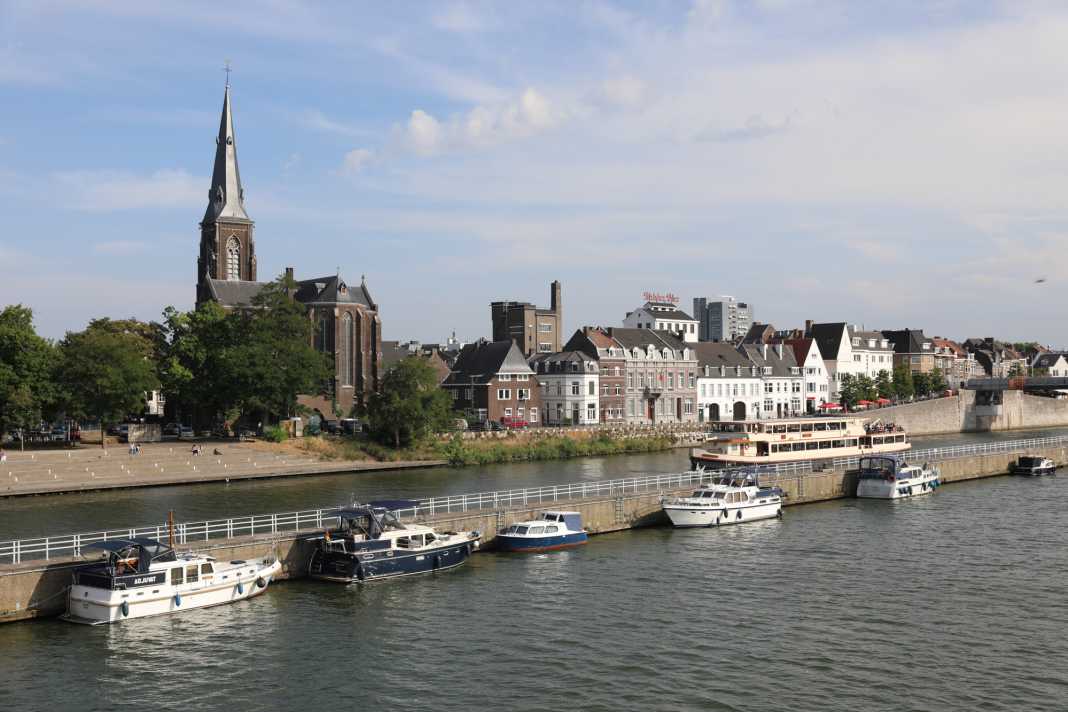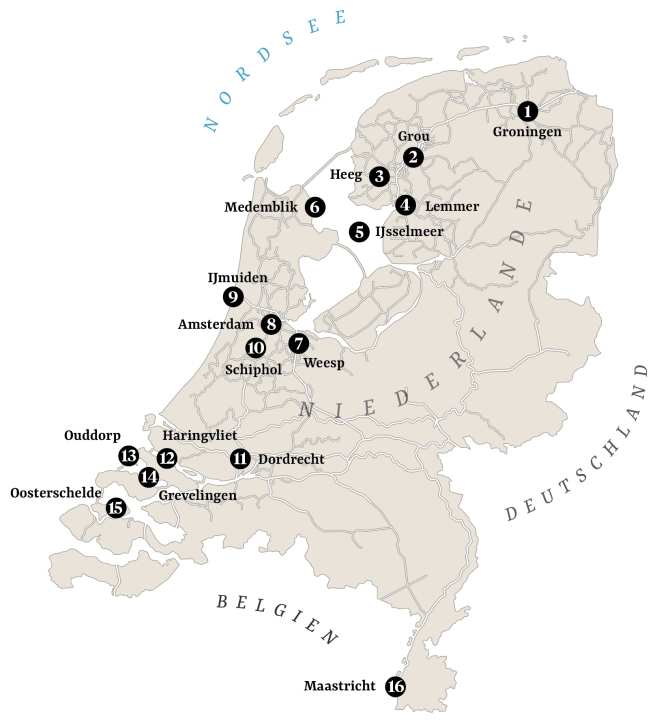Season planner 2024: Netherlands - what recreational boaters should know now






News from
The Dutch are continuing to invest heavily in maritime infrastructure, as it is becoming increasingly outdated. Some hydraulic structures are becoming more and more susceptible to failure. In some cases, repairs are not enough, as spare parts for old bridges and locks are hardly available. Complex refurbishment is then unavoidable. This was also the case with the Haringvlietbrug. It could no longer be operated safely, which is why the replacement of the movable bridge section, including the drive and control system, was unavoidable. This renovation ultimately took six months longer than planned, but the bridge will finally be open again in time for the coming season.
This example shows how important leisure shipping is in the neighbouring country. The clearance height of the Haringvliet Bridge when closed is 13 metres. This means that most freighters can pass underneath, while the bridge is mainly opened for sailing yachts. The same applies to the Driebondsbrug near Groningen. It has also been repaired and will function as usual from the start of the season. The northern Staande Mastroute now starts again at Delfzijl.
Some sections of the popular Staande Mastroute cannot be travelled due to bridge closures
In the south, the situation is less favourable for the popular inland route for tall ships: The Schipholbrug was also due to receive a new flap. Unfortunately, as it turned out, the concrete construction was too weak for the new, wider and therefore heavier flap. The repairs will now take a good year longer. In the meantime, the bridge remains closed. This means that the Staande Mastroute in Amsterdam is only passable at a maximum height of 6.20 metres.
If you still want to drive through the city centre, you have to go via Haarlem. The closures on the alternative route due to repairs were lifted at the end of March. Prior to this, nothing worked on the western alternative route for yachts either. So the good news is that investments are being made and repairs are being carried out. The bad news is that there are repeated closures for this reason. These have to be accepted if bridges and locks are to function again for decades afterwards.
Another issue that is causing a stir in the Netherlands is the question of whether AIS data can be used by authorities to punish traffic offences. Initially, this concerns speeding offences. However, once on-screen monitoring is authorised, the road to monitoring routes, for example in traffic separation schemes or wind farms, is not far away. One of the questions that arises here is whether data from privately installed and operated devices can and may be used for criminal prosecution at all. The debate on this has now flared up in the Netherlands. How it will end is still uncertain.
A thorough inspection has been ordered for flat-bottomed ships travelling with guests
Incidentally, this was preceded by a fatal accident on the mudflats near Terschelling, in which both vehicles were travelling far too fast. The Onderzoeksraad voor Veiligheid, comparable to the German Federal Bureau of Maritime Casualty Investigation, then recommended stricter speed control in general. AIS data could be used for this. However, this is precisely what was ruled out in an agreement with the inland shipping industry, which has since expired, when an AIS obligation was introduced.
The fatal accidents that occurred on flat-bottomed ships had very similar consequences. Here, too, there was an investigation report. It revealed that, on the one hand, there were serious technical defects on the ships. In addition, the ship's command was also criticised. The responsible minister therefore ordered a complete inspection of the entire fleet. Those that have not passed the inspection are no longer allowed to sail with guests on board.
The problem is that not all of the 240 or so ships will have been inspected by the start of the season. Guests who have booked a trip on a flat-bottomed ship early in the year should contact the shipping company immediately and ask about the inspection problems. It has already emerged that around a quarter of the boats that have already been inspected have serious defects. These must be rectified.
Finally, some good news: the practical "HP 33" current atlas is now also available in digital form. To do this, you need to download an app from the website of the Ministry of Defence, which is responsible for nautical charts: www.defensie.nlenter "NLTides - HP33D" in the search field.
The following is a list of what else has happened in the Netherlands.

1st Groningen
Since 12 March this year, the Driebondsbrug has been operating as usual again. However, from Monday to Friday from 7 a.m. to 9 a.m. and from 4 p.m. to 6 p.m. only for commercial shipping. Outside of these times, the bridge will open for boats every half hour on weekdays, 15 minutes before and after the hour. At weekends, recreational craft have unrestricted access, and there are no special openings for commercial shipping only.
2. grou
The harbour on the Pikmeer was dredged and is now said to be at least two metres deep. The same goes for Hellingshaven. The jetties and electrics have also been renewed here. The Hellingshaven is still reserved for boats up to twelve metres in length.
3rd Heeg
There was still hope last year, but it was short-lived: the popular "Oude Vishal" is no more. The owners had to close due to ill health.
4th Lemmer
Sad news: Henk de Boer from Nautic Shop Lemmer has passed away. His son Hendrik de Boer, who was previously the owner, continues to run the shop, which also sells water sports articles that are no longer actually available.
5th IJsselmeer
Overgrowing aquatic plants, which can be a massive hindrance to recreational boating, were previously mainly a problem in the Markermeer and the marginal seas. Last season, they were also spotted along the Frisian IJsselmeer coast. Corresponding reports were received from users of the water sports portal stegfunk.de. So far, however, there has been no talk of any disruption for boaters.
6 Medemblik
He was literally known as a colourful dog for 35 years: the always friendly harbour master with his yellow bicycle and red overall. Now René Waldram is retiring. It will be interesting to see whether the yellow bike will still be spotted around the harbour from time to time.
7. weesp
The municipality through which the Vecht flows has been part of Amsterdam for some time. This means that the vignette is also required for travelling on the waters of Amsterdam. The municipality has postponed the introduction until January 2025, as many charter companies operate their bases along the Vecht. The problem is that you can only obtain one vignette per address. But that is difficult if you hire out a lot of boats. The authorities are now looking for a solution.
8 Amsterdam
And once again on the subject of vignettes: if you buy one, you first have to activate it to make it valid. To do this, you receive an activation code in a separate e-mail from the municipality. Recently, however, readers have reported being told that the vignette has already been activated and that activation by the buyer is therefore not necessary. However, this was probably an oversight on the part of the issuing authority. The subsequent activation by the buyer is therefore still required. If you are unsure whether your vignette is valid or not, you can contact us with the vignette number at vaarvignet@amsterdam.nl contact. They will then check whether activation has already taken place or not.
Amsterdam's city authorities are getting serious about environmental protection: from next year, ships with combustion engines will no longer be allowed to sail within the canal belt. And there is news of a major construction project: the municipality of Amsterdam has earmarked 100 million euros for a bridge across the IJ over the next few years. It will connect the Java Island in the south with the Aeolushaven in the north. It is not yet clear when the structure will be built. However, as the people of Amsterdam really want it, the pressure on the politicians responsible is high.
Nothing is happening elsewhere for the time being either: the fairway to Amsterdam has become narrower between the Schellingwouderbrug and the IJmeer. The edges of the deep fairway are crumbling away. Instead of dredging, the buoys were moved so that the section is now narrower for commercial vessels. Fortunately, the separate fairway for recreational shipping next to it has been preserved.
9th IJmuiden
Following the construction of the new, large lock, the sea locks in IJmuiden are now being renovated one after the other. The aim is to minimise disruption to shipping as much as possible. Planning initially began in 2023 and construction work may start this year.
10 Schiphol
The Schipholbrug south of Amsterdam, which is part of the Staande Mastroute, cannot be opened. The passage is currently only possible for boats with a height of up to 6.30 metres. The work is not due to be completed until May next year.
11th Dordrecht
Due to their age, some bridges in the area of the municipality can no longer be operated in winds stronger than five. They are also located on the Staande Mastroute. However, another bridge in Dordrecht, over the Merwede, is not part of the Staande Mastroute. It is expected to be out of service until the end of May. The reason: there is no longer a spare part for a defective relay. Until the engineers have found another solution, the bridge will remain closed.
12th Haringvliet
The Haringvlietbrug has been operating again since 28 March. However, exact opening times are yet to be announced. It can be assumed that the bridge will remain closed during the morning and afternoon rush hour.
13th Ouddorp
The Verkeerspost, which monitored shipping traffic south of the Europort, on the Grevelinger Meer and the Haringvliet, has been closed. This creates unsafe situations, as the control centre was also the first point of contact, for example by radio, for the situation in the treacherous Slijkgat. Caution is now required there, especially at low tide after heavy storms, as the fairway may have changed.
14th Grevelingen Sea
After a whopping increase of 56 per cent in the previous year, the Grevelingen Card is set to become more expensive again, by 26 per cent. This means that the price has almost doubled since 2022. When asked, the responsible authority stated that the costs for monitoring compliance with the demurrage rules in particular had increased.
15th Oosterschelde
The Zandkreek lock between the Oosterschelde and the Veerse Meer needs to be renovated. For this reason, it will be closed again and again: from 25 March to 26 April from Monday to Friday from 6.30 am to 4 pm, from 2 to 13 September from 6.30 am to 4 pm, from 16 to 29 September even completely and from 30 September to 4 October again from 6.30 am to 4 pm.
16th Maastricht
Work on widening the Julianakanaal was halted after water broke into a previously drained excavation pit in 2022. It was only with luck that no one was injured. However, work has been at a standstill since then; it is unclear when it will resume. Anyone passing the construction site may drive at a maximum speed of six kilometres per hour. Please note that the speed limit is enforced.

